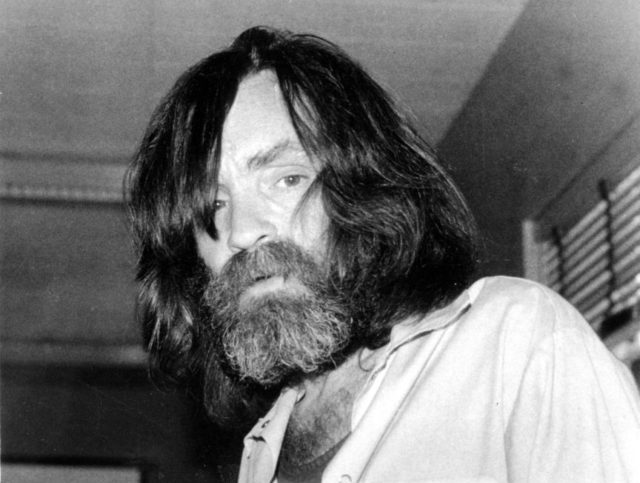A New York Times op-ed claims that Charles Manson “had more in common ideologically with far-right groups like the John Birch Society than he did with the anarchic leftism of, say, the Yippies.”
The 23-years-dead founder of the Yippies, to say nothing of the photograph above, disagrees.
“I fell in love with Charlie Manson the first time I saw his cherub face and sparkling eyes on TV,” Jerry Rubin wrote in 1971. Rubin knew Manson. He made the pilgrimage to Los Angeles County Jail to meet with Manson. The bearded pair talked for three hours and bonded. “His words and courage inspired us,” Rubin reflected of the serial killer. “Manson’s soul is easy to touch because it lays quite bare on the surface.”
Manson showed his admiration for Rubin by imitating his courtroom tactics. The grubby guru’s frequent interruptions of the judge and lawyers, use of the courtroom as a soapbox, and reorientation of the legal proceedings into a media circus all came from Rubin and his fellow Chicago Seven defendants. Manson didn’t borrow from Rubin here. He copied him.
In praising Manson, Rubin did not succumb to a momentary lapse of reason. Weatherman leaders Bernardine Dohrn, Kathy Boudin, and Diana Oughton also paid homage to the Manson Family and mocked its victims. Burgeoning radical newspapers, such as The Los Angeles Free Press and Rolling Stone, glorified Manson. Radical figures in a radical age demonstrated their radicalism by imagining Charles Manson as standing on the side of the angels.
Most people on the political Left, like most people, despised the murderer. But a sizable number, more than a hand can count, of significant figures on the American Left attempted to make a folk hero out of a serial killer. They portrayed Manson as one of their own. And Manson, who ate from supermarket dumpsters, traveled about in a black-painted school bus, spent the Summer of Love in Haight-Ashbury, distributed LSD to followers sacramentally as though communion wafers, organized frequent orgies, embraced new religions, wore his hair long, and played folk music on his guitar, did very little to persuade them, to borrow the words of the New York Times headline, that “Charles Manson Was Not a Product of the Counterculture.”
Manson, of course, did not go to John Birch Society meetings. His partying circles brought him in contact with the Mamas and the Papas and Neil Young and the Beach Boys. He did not recruit from Sunday schools or American Legion halls or the Girl Scouts troops. He grabbed his followers from Anton LaVey’s Church of Satan, Wavy Gravy’s Hog Farm, and the Cal-Berkeley Library. He did not attend speeches by Robert Welch. He tripped on acid in the fetal position at a San Francisco Grateful Dead concert.
Surely Manson did not represent the counterculture. Most people who grew their hair and smoked grass and listened to Jefferson Airplane did not murder people or fantasize about murdering people or anything like that. But Charles Manson, even if he did not represent this side of the sixties, did come out of it.
This complicates the narrative. Ignore the war, the assassinations, the riots, the bombings, and the murder rate. The sixties were about peace and love. Really, they were. So, Charles Manson, as sixties as Tiny Tim and Laugh In and “In-A-Gadda-Da-Vida” and Abbie Hoffman, becomes something else to suit the needs of the present. The Times writer, who also calls the Tate-LaBianca murders, which exclusively claimed white people as victims, “racist,” creates a fantasy version of Charles Manson as the man who provided “the DNA of the reactionary alt-right.” This clashes with the facts. But someone who invokes the Yippies to prove Manson’s disconnect from such people, when the man most associated with the Yippies praised the mass murderer and visited him in jail, surely prefers the a priori wisdom provided by ideology to facts, which, as John Adams reminded, are stubborn things.
“Charles Manson Was Not a Product of the Counterculture”? Whether Times op-ed writer Baynard Woods sees Manson as part of the counterculture, Manson, Jerry Rubin, and so many other counterculture figures saw Manson as part of the counterculture.

COMMENTS
Please let us know if you're having issues with commenting.